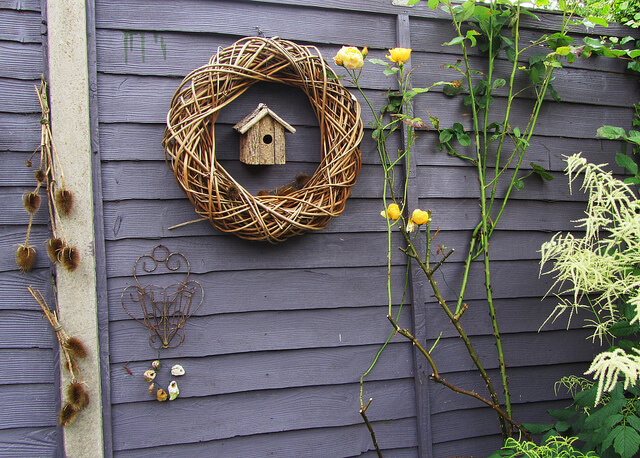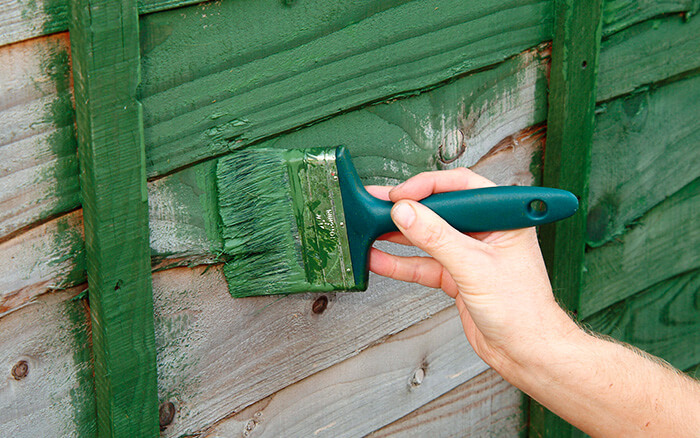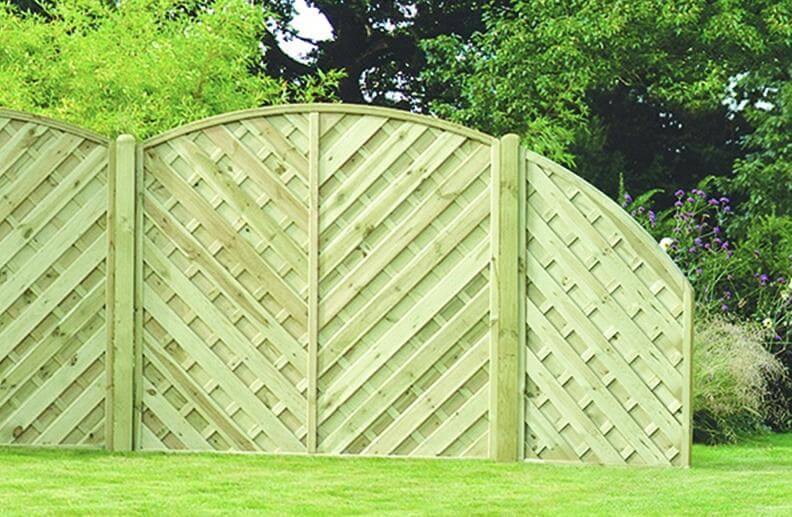The humble garden fence can serve a variety of purposes, either as the boundary between one property and the next, a division from one garden area to another, or as a screen to hide away a compost pile or the wheelie bins. No matter what the reason, wooden fence panels don’t have to be the plain, functional, fixtures that we tend to think of them as.

Why Treat Wooden Fence Panels?
Putting in a new garden fence, especially if professionally erected can be costly. Anything that protects the timber, and ultimately the integrity and life of the fence is going to protect your investment. To ensure that fence panels and posts stay in tip top condition for longer, we recommend using a quality fence treatment
Garden Fence Protection and Preservation
New garden fence panels are usually tanalised or pressure treated with a wood preserver before leaving the factory. This said, applying an additional wood preserver to all sides and edges before installation will provide additional protection. A good quality wood preservative will protect wooden fences and posts from a variety of biological threats including mould, algae, dry rot, and insect attack. Applying a good quality wood preserver to new or structurally sound older panels can offer years of additional protection.
Can You Use Decking Oil on Fence Panels?
In short ‘Yes’. Decking oils are perfect for protecting and preserving wooden fence panels. The oil penetrates into the timber and provides the wood with excellent water resistance. Choose from a wide range of options depending on the type of finish you would like. Clear decking oils will enhance the natural grain and colour of the wood whilst a coloured oil can be used to stain new or older fences. Coloured decking oils are available in a wide range of natural wood tone colours including Teak, Oak, and Pine, as well as some alternative colours. Some oils also include added UV filters that offer wood enhanced protection against sun and UV damage.
Keeping it Natural or Adding Colour?
To keep fence panels looking natural, simply use a clear wood preservative and clear decking oil as a top coat. These products will enhance the natural grain of the timber and will initially give the wood an almost damp like appearance, whilst retaining the natural beauty of the wood grain. To stain new or older fence panels, there are a variety of coloured wood preservers and wood oils, translucent, semi translucent, and opaque, to achieve any effect.
How to give the best protection to Garden Fence Panels?
To get the best level of protection, it is recommended to use both a wood preservative, usually 2 coats, followed by 2 coats of decking oil or other exterior wood oil. Ideally, it’s best to treat both sides and all edges prior to installation.
Note: When using solvent based wood preservatives, it’s important to follow the manufacturer’s drying times. Although solvent based wood preservers usually feel dry in around 4 to 6 hours, the recommended drying times are usually around 48 hours. Why is this? Simply speaking the solvent content of any preservative must be allowed to fully evaporate from the wood before applying a wood oil or other fence treatment. Solvents break down and dissolve waxes and oils so if the oil is applied to early, the solvent from the preservative may affect the oil top coat making it less effective.
How to colour Garden Fences
Wood preservers are available in a wide range of colours such as Cedar Red, Summer Tan, Holly Green and Golden Brown to name just a few. These can be applied to colour or stain a fence prior to overcoating with a clear decking oil. An alternative approach is to use a clear wood preservative then overcoat with a coloured wood oil or decking oil.

The benefits of using a wood preservative and wood oil combinations over a fence paint is that the finish will not crack, peel, or flake, as some types of wood paint tend to do over time. To freshen the finish, all that is needed is a re-application of the oil top coat as and when needed.
When to replace fence panels
Unfortunately, in situations where fence panels and posts have never been treated or have been left untreated for a number of years, issues such as wet rot, mould, and algae may have taken too much of a toll. If the wood is decayed, rotted, or the panel is simply falling apart, it’s time to replace. The important thing here is to correctly treat the new fence panels and posts so that they don’t suffer the same fate as the old.
For more information on the types of garden fence treatments click here.
Where to Buy Garden Fence Panels for Less
Whether looking to replace just one fence panel, a whole stretch or garden fence, shopping around for the cheapest deals can save a small fortune. In addition to garden centers and high street retailers such as B&Q and Homebase, there are some excellent online resources that can save you money and deliver to the front door.
Online retailers often offer great prices, discounts, and offers. Some also offer a range of finance options making buying a new fence more affordable with payments spread out over time.
Recommended Fence and Shed Suppliers
- Garden fence panels and accessories on Amazon
- Discounted Fence Panels at Sheds.co.uk
- Buy Fence Panels at BuyShedsDirect.co.uk
Styles of Wooden Garden Fencing
It’s true to say that garden fence panels come in a wide variety of shapes, sizes, and styles. From traditional feather-board and overlap fence panel to the more stylish Paloma panels or Valencia type fence panels. No matter what shape, size, or style of garden you have, the right garden fence can make a huge difference to its visual appeal.

Can’t find the answer to your garden fence care or maintenance project above? See our frequently asked garden fence questions and answers page, where we try to answer some of the more commonly asked questions relating to garden fence care, maintenance, and fence treatments.
Garden Fence FAQ’s
In addition to garden fencing, read our top tips on protecting and preserving garden sheds, wooden decking, and garden furniture.
